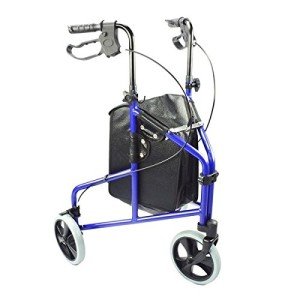
Rollator Walker
إضافة إلى استعراض اتبعنظرة عامة
-
تأسست تاريخ مارس 7, 1945
-
القطاعات قانون
-
نشر الوظائف 0
-
ينظر 21
وصف الشركة
The 10 Most Scariest Things About Medical Walker
Understanding Medical Walkers: A Comprehensive Guide
Medical walkers work as vital mobility aids for individuals recovering from surgical treatment, managing persistent illnesses, or dealing with age-related Compact 4-Wheel Mobility Scooter Walker with Seat problems. These devices not just improve physical self-reliance but also enhance safety, permitting users to navigate their environments with higher ease. This article checks out the types, benefits, features, and factors to consider associated with medical walkers, in addition to some often asked concerns.
Tabulation
- Kinds Of Medical Walkers
- Benefits of Using a Medical Walker
- Key Features to Consider
- Regularly Asked Questions
- Conclusion
1. Kinds Of Medical Walkers
Medical walkers are readily available in various designs, dealing with different needs and preferences. The main types include:

| Type of Walker | Description |
|---|---|
| Requirement Walker | A rectangle-shaped frame with 4 legs, providing stability and support. |
| Two-Wheeled Walker | Comparable to a standard walker but geared up with wheels at the front for simpler motion. |
| Three-Wheeled Walker | A Lightweight Pink Tri Walker with Lockable Brakes walker with 3 wheels, permitting more maneuverability, ideal for indoor use. |
| Sturdy Rollator Walker | A walker with four wheels, hand brakes, and a seat, ideal for longer ranges and resting needs. |
| Hemi Walker | Developed for people who can use only one hand, including a tripod-like style. |
2. Benefits of Using a Medical Walker
Utilizing a medical walker presents a number of benefits that add to the user’s overall well-being, including:
- Increased Stability: Walkers offer a steady base of support, minimizing the danger of falls.
- Improved Mobility: They enable users to move around more quickly, promoting independence.
- Pain Relief: By redistributing weight, walkers can relieve pain in the joints, especially in the hips and knees.
- Posture Support: These devices encourage correct posture, lowering strain on the back.
- Enhanced Confidence: Users typically feel more protected using walkers, resulting in much better self-confidence and increased activity levels.
3. Key Features to Consider
When picking a medical walker, it’s crucial to evaluate numerous features to find the right fit. Here are some crucial aspects to think about:
- Weight Capacity: Ensure the walker can support the user’s weight while preserving stability.
- Height Adjustment: Look for a walker with adjustable height settings to accommodate the user’s height and provide comfortable grip.
- Product: Days Lightweight Folding Walker with Seat – Mobility Made Easy aluminum walkers are simpler to navigate, while steel walkers provide more powerful assistance however might be heavier.
- Wheel Quality: If going with a wheeled walker, think about the wheel size and tread. Bigger wheels browse uneven surface areas more easily.
- Seat Availability: If users will be walking for longer durations, a walker with an integrated seat can supply rest breaks when required.
- Brakes: Hand brakes are particularly important for safety in rollator walkers to control speed and stop when required.
Types of Walkers with Features Comparison Table
| Walker Type | Weight Capacity | Height Adjustment | Wheels | Seat Available | Brakes |
|---|---|---|---|---|---|
| Requirement Walker | Up to 300 pounds | Yes | No | No | No |
| Two-Wheeled Walker | Up to 300 lbs | Yes | Yes | No | No |
| Three-Wheeled Walker | Up to 250 pounds | Yes | Yes | No | No |
| Rollator Walker | Approximately 400 lbs | Yes | Yes | Yes | Yes |
| Hemi Walker | Approximately 250 pounds | Yes | No | No | No |
4. Often Asked Questions
Q1: Who must use a medical walker?A: Medical walkers are helpful for individuals recuperating from surgery, experiencing balance problems, or requiring assistance due to age-related mobility obstacles. Q2: Can a medical walker be adjusted?A: Yes, a lot of
medical walkers are height-adjustable to accommodate different user heights, permitting a more comfy grip. Q3: How do I select the best walker for my needs?A: Consider aspects such as the
user’s weight, height, type of mobility issues, and whether they require a seat or brakes. Checking the walker for comfort and stability before purchase is likewise advisable. Q4: Are there any safety pointers connected with using a medical walker?A: Yes, users should ensure they don’t lean too
greatly on the walker, use it on stable and level surfaces, and constantly guarantee
the brakes are engaged when seated or stationary. Q5: Can walking with a medical walker assist with rehabilitation?A: Absolutely. Medical walkers are often advised as part of rehabilitation programs as they motivate
physical activity, which aids in healing and mobility improvement. 5.
Conclusion Medical walkers play a vital function in boosting the lifestyle for people dealing with mobility challenges. With various types and features available, selecting the ideal walker involves considering the user’s specific needs and scenarios. By comprehending their benefits and correct use, individuals can regain self-reliance, improve their mobility, and browse their surroundings securely. Whether for short-term healing or long-term support, the right medical walker can substantially enhance a user’s general well-being. Incorporating a medical walker into one’s daily routine can be a transformative choice, making it easier to take part in life’s everyday activities while making sure safety and self-confidence.
